Green Energy
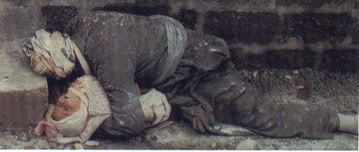
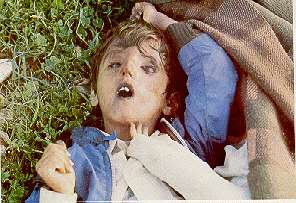

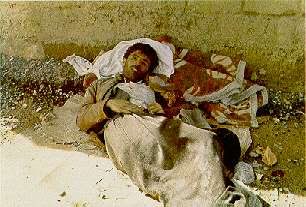
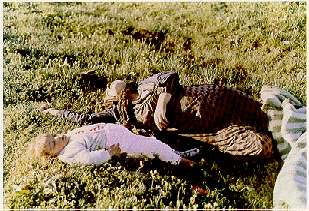
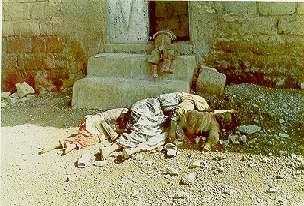
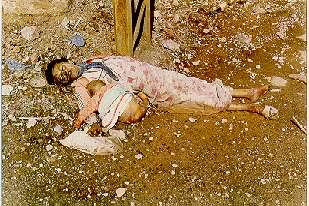
We were burnt as newly-grown plants,
In the current of poisonous winds,
And showed our dreadful wounds,
From one side of the world to the other.
But the unjust eyes of the world
Were never opened truly towards the oppressed.
The world only confined itself to a false regret, And once again,
We became a target as heaps and heaps of martyrs, We were the target of poisonous bombardments, We were the target of destructive bombs, And we remained the lonely oppressed ones of the world.
We rose from under tons of debris,
And stood up in the lands of poisonous bombings,
And we kept up standing and fighting,
Believe it, you people of tomorrow,
Believe such a history and learn a lesson,
Learn how to fight oppression in this way.*
* From the poem "Khaibar" by Mohammed Reza Abdol-Malakian.

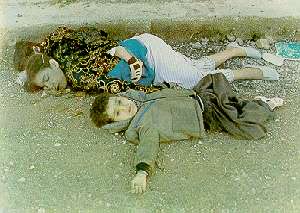
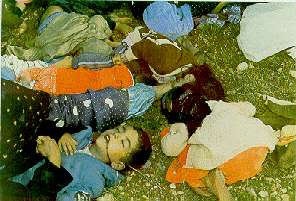
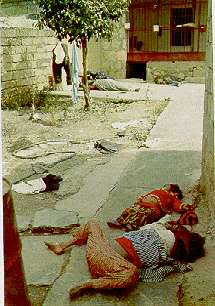
What happened to Halabja on the Bloody Friday?
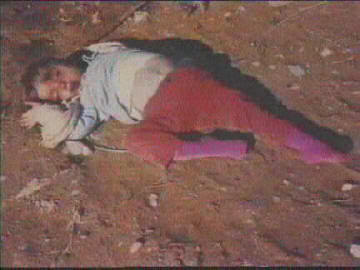
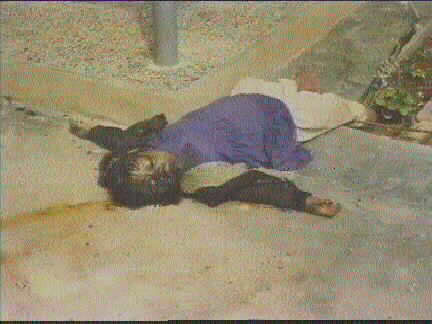
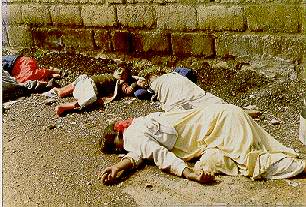
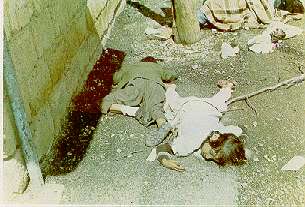
The Gases Deployed against the People of Halabja

On the borders of Kurdistan
On the borders
Where throats are
Choked with good-byes
And eagerness is
Suspended in the eyes
And people asked
When.. where are we ? why..?!
Here a child dies..
There a baby lies, and
Another face-down cries:
My wound is hurting
My breath is hurting
My stomach is hurting,
Mother: Am I to die ?
And my white pigeon ?!
Are we going to die ?
In tears she said:
There beyond the border posts..
Only days: we won't die
For us, God will try..
Again, the child cries:
Will my pigeon die ?
Mother: I love her..
She is my life
Because I love,
She does not deserve to die
I love her...
All broke in tears
Dear.. your pigeon died
When the planes pried
And she broke in tears
My white pigeon was gassed ?!
My Kurdish pigeon died
Mother.. my hair is falling
why ? Am I do die ?
Some water please..
W-a-t-e-r ...
MANY THANX
Alex Atroushi

http://islamonthisday.blogspot.com/2008/03/on-this-day-march-17.html
- Saddam-era Chemical Weapons Now Under Isis Control: Reports - Are These The Chemical Weapons They Recently Used?
Saddam-Era Chemical Weapons Now Under ISIS Control: Reports Correction: In the original story, the name of the city where the chemical weapons facility is located was incorrectly mentioned as Muthanna in the third paragraph. While the name of the weapons...
- Photographs Suggest Isis Used Chemical Weapons Against The Kurds In Kobahne
From the Jerusalem Post: Photographs obtained by the Middle East Review of International Affairs (MERIA Journal) which were published on Sunday appear to support claims that the Islamic State used chemical weapons against Kurdish fighters...
- Is Turkey Using Chemical Weapons On The Kurds?
Kurdish guerrillas denounced use of chemical weapons in air raids by Turkish army (Firat).People’s Defence Forces press office HPG-BIM has reported that at least 24 guerrillas lost their lives as a result of severe clashes and air attacks where chemical...
- Justice And Vengence: Chemical Ali Hanged
Newsmax Iraq's 'Chemical Ali' Infamous for 1988 Gas Attack Monday, 25 Jan 2010 11:47 AM Saddam Hussein's cousin Ali Hassan al-Majid, who was hanged Monday, ordered the infamous poison gas attack on the northern Iraqi Kurdish village of...
- Iran's Fingerprints Keep Showing Up All Over Iraqi Terrorism
Mustafa smirks when he tells me he is a “secularist” who does not pray and boasts about enjoying whiskey, drugs and prostitutes. He is a Sunni who does not mind working for Shia, provided the pay is good. And far from being a patriot, he betrayed...
Green Energy
ON THIS DAY March 17
Politically Incorrect Guide
SUBLIME AND GENTLE HAND
Nasty Friday
Chemical massacre of the Kurds by the Iraqi regime
Halabja- March 17 1988

The pictures below are said to have been taken in the aftermath of Saddam's attack using chemical weapons and cluster bombs on the Kurdish city of Halabja (population estimated at 70,000) on March 17, 1988. Halabja is located about 150 miles northeast of Baghdad and 8-10 miles from the Iranian border. The attack, said to have involved mustard gas, nerve agent and possibly cyanide, killed an estimated 5,000 of the town's inhabitants. The attack on Halabja took place amidst the infamous al-Anfal campaign, in which Saddam brutally repressed yet another of the Kurdish revolts during the Iran-Iraq war. Saddam is also said to have used chemical weapons in attacking up to 24 villages in Kurdish areas in April 1987.



" The skin of the bodies is strangely discolored, with their eyes open and staring where they have not disappeared into their sockets, a grayish slime oozing from their mouths and their fingers still grotesquely twisted.


" Death seemingly caught them almost unawares in the midst of their household chores. They had just the strength, some of them, to make it to the doorways of their homes, only to collapse there a few feet beyond. Here a mother seems to clasp her children in a last embrace, there an old man shields an infant from he cannot have known what...


We were burnt as newly-grown plants,
In the current of poisonous winds,
And showed our dreadful wounds,
From one side of the world to the other.
But the unjust eyes of the world
Were never opened truly towards the oppressed.
The world only confined itself to a false regret, And once again,
We became a target as heaps and heaps of martyrs, We were the target of poisonous bombardments, We were the target of destructive bombs, And we remained the lonely oppressed ones of the world.
We rose from under tons of debris,
And stood up in the lands of poisonous bombings,
And we kept up standing and fighting,
Believe it, you people of tomorrow,
Believe such a history and learn a lesson,
Learn how to fight oppression in this way.*
* From the poem "Khaibar" by Mohammed Reza Abdol-Malakian.


Halabja, standing against oppression Joy and happiness permeated the air in Halabja.
Smiles never faded from the lips of the ever oppressed people of this town.
The Iraqi fighter planes carried out the chemical bombing of Halabja, and some hours later the news came that Khormal, too, had suffered chemical bombing.
The sound of laughter died down. Children sought the shelter of their mothers' arms.
March 16, was the beginning of the great crime of history. On Thursday March 17, 1988, and on Friday March 18 the holy day of prayer, there took place one of the most shameful and fearful inhumane crimes of history in Halabja. The town of Halabja was bombed with chemical and cluster bombs more than twenty times by Iraqi fighter planes.
In every street and alley women and children rolled over one another. The sound of crying and groans rose from every house in the town. Many families who were sleeping happily in their beds in their liberated town, were subjected before sunrise to chemical bombing, and poisonous gases did not even allow them to rise from their beds.
Such was the situation on the bloody Friday of Halabja.
Smiles never faded from the lips of the ever oppressed people of this town.
The Iraqi fighter planes carried out the chemical bombing of Halabja, and some hours later the news came that Khormal, too, had suffered chemical bombing.
The sound of laughter died down. Children sought the shelter of their mothers' arms.
March 16, was the beginning of the great crime of history. On Thursday March 17, 1988, and on Friday March 18 the holy day of prayer, there took place one of the most shameful and fearful inhumane crimes of history in Halabja. The town of Halabja was bombed with chemical and cluster bombs more than twenty times by Iraqi fighter planes.
In every street and alley women and children rolled over one another. The sound of crying and groans rose from every house in the town. Many families who were sleeping happily in their beds in their liberated town, were subjected before sunrise to chemical bombing, and poisonous gases did not even allow them to rise from their beds.
Such was the situation on the bloody Friday of Halabja.


What happened to Halabja on the Bloody Friday?
The brutal massacre of the oppressed and innocent people of Halabja began before the sunrise of Friday, 18th of March 1988. The Iraqi regime committed its most tragic and horrible crime from the beginning of the imposed war until now against the civilian people on Friday, 18th of March. On that day, Halabja was bombarded more than twenty times by Iraqi regime's warplanes with chemical and cluster bombs. That Friday afternoon, the magnitude of Iraqi crimes became evident. In the streets and alleys of Halabja, corpses piled up over one another. Tens of children, while playing in front of the their houses in the morning, were martyred instantly by cyanide gases. The innocent children did not even have time to run back home. Some children fell down at the threshold of the door of their houses and never rose again.


A mother who embraced her one-year-old baby, fell down two steps from her house and was martyred. In a 150 meter area in the main street of Halabja, at least fifty women and children were martyred as a result of the deployment of the chemical weapons. A father was sitting over the bodies of his wife and ten of his children in one of the alleys of Halabja and was wailing. The sound of his wailing touched any cruel human being. The crimes were huge, very huge.
In a Simorgh Van, the corpses of 20 women and children who had been prepared to leave the town and the chemical bombardment of the town had deprived them of this opportunity, made any observer stop and ponder about the depth of the catastrophe. Fatal wounds on the corpses of these innocent people were evident.
In a Simorgh Van, the corpses of 20 women and children who had been prepared to leave the town and the chemical bombardment of the town had deprived them of this opportunity, made any observer stop and ponder about the depth of the catastrophe. Fatal wounds on the corpses of these innocent people were evident.
The doors of most houses were left open and inside of each house, there were some martyred and wounded people.
The enemy had heightened the cruelty and heart-handedness to its peak and took no pity on its own people.
Saddam's crime in the chemical bombardment of Halabja has indeed been unprecedented in the history of
the imposed war. Saddam's crime in Halabja can never be compared to the tragedy of the chemical bombardment of Sardasht. In Halabja more than five thousand people were martyred and over seven thousand more people were wounded.
The enemy had heightened the cruelty and heart-handedness to its peak and took no pity on its own people.
Saddam's crime in the chemical bombardment of Halabja has indeed been unprecedented in the history of
the imposed war. Saddam's crime in Halabja can never be compared to the tragedy of the chemical bombardment of Sardasht. In Halabja more than five thousand people were martyred and over seven thousand more people were wounded.
Women and children formed 75 percent of the martyrs and wounded of the bloody Friday of Halabja.


The Gases Deployed against the People of Halabja
The Iraqi regime, in the chemical bombardment of Halabja and the surrounding towns and villages, has deployed
three kinds of chemical gases. According to the findings of Iranian physicians, the mustard, nerve and cyanide gases have been used against civilians in Halabja and its surroundings. A group of the martyrs of the chemical bombardment of Halabja, after inhaling the cyanide gas, were suffocated immediately. Post-mortem examination of the bodies of the chemical bombardment of Halabja, has proved that the suffocation of the most of the martyrs has been due to the inhalation of cyanide gas.
three kinds of chemical gases. According to the findings of Iranian physicians, the mustard, nerve and cyanide gases have been used against civilians in Halabja and its surroundings. A group of the martyrs of the chemical bombardment of Halabja, after inhaling the cyanide gas, were suffocated immediately. Post-mortem examination of the bodies of the chemical bombardment of Halabja, has proved that the suffocation of the most of the martyrs has been due to the inhalation of cyanide gas.

On the borders of Kurdistan
On the borders
Where throats are
Choked with good-byes
And eagerness is
Suspended in the eyes
And people asked
When.. where are we ? why..?!
Here a child dies..
There a baby lies, and
Another face-down cries:
My wound is hurting
My breath is hurting
My stomach is hurting,
Mother: Am I to die ?
And my white pigeon ?!
Are we going to die ?
In tears she said:
There beyond the border posts..
Only days: we won't die
For us, God will try..
Again, the child cries:
Will my pigeon die ?
Mother: I love her..
She is my life
Because I love,
She does not deserve to die
I love her...
All broke in tears
Dear.. your pigeon died
When the planes pried
And she broke in tears
My white pigeon was gassed ?!
My Kurdish pigeon died
Mother.. my hair is falling
why ? Am I do die ?
Some water please..
W-a-t-e-r ...
Alex Atroushi

http://islamonthisday.blogspot.com/2008/03/on-this-day-march-17.html
- Saddam-era Chemical Weapons Now Under Isis Control: Reports - Are These The Chemical Weapons They Recently Used?
Saddam-Era Chemical Weapons Now Under ISIS Control: Reports Correction: In the original story, the name of the city where the chemical weapons facility is located was incorrectly mentioned as Muthanna in the third paragraph. While the name of the weapons...
- Photographs Suggest Isis Used Chemical Weapons Against The Kurds In Kobahne
From the Jerusalem Post: Photographs obtained by the Middle East Review of International Affairs (MERIA Journal) which were published on Sunday appear to support claims that the Islamic State used chemical weapons against Kurdish fighters...
- Is Turkey Using Chemical Weapons On The Kurds?
Kurdish guerrillas denounced use of chemical weapons in air raids by Turkish army (Firat).People’s Defence Forces press office HPG-BIM has reported that at least 24 guerrillas lost their lives as a result of severe clashes and air attacks where chemical...
- Justice And Vengence: Chemical Ali Hanged
Newsmax Iraq's 'Chemical Ali' Infamous for 1988 Gas Attack Monday, 25 Jan 2010 11:47 AM Saddam Hussein's cousin Ali Hassan al-Majid, who was hanged Monday, ordered the infamous poison gas attack on the northern Iraqi Kurdish village of...
- Iran's Fingerprints Keep Showing Up All Over Iraqi Terrorism
Mustafa smirks when he tells me he is a “secularist” who does not pray and boasts about enjoying whiskey, drugs and prostitutes. He is a Sunni who does not mind working for Shia, provided the pay is good. And far from being a patriot, he betrayed...
